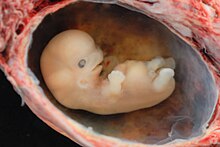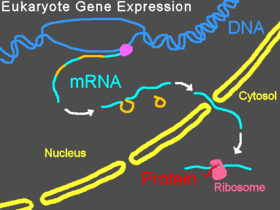Morpholinos have become a standard knockdown tool in animal
embryonic systems, which have a broader range of gene expression than adult
cells
and can be strongly affected by an off-target interaction. Following
initial injections into frog or fish embryos at the single-cell or
few-cell stages, Morpholino effects can be measured up to five days
later,
[31] after most of the processes of
organogenesis and
differentiation are past, with observed
phenotypes consistent with target-gene knockdown.
Control
oligos with irrelevant sequences usually produce no change in embryonic
phenotype, evidence of the Morpholino oligo's sequence-specificity and
lack of non-antisense effects. The dose required for a knockdown can be
reduced by coinjection of several Morpholino oligos targeting the same
mRNA, which is an effective strategy for reducing or eliminating
dose-dependent off-target RNA interactions.
[32]
MRNA rescue experiments can often restore the
wild-type
phenotype to the embryos and provide evidence for the specificity of a
Morpholino. In an mRNA rescue, a Morpholino is co-injected with an mRNA
that codes for the morphlino's protein. However, the rescue mRNA has a
modified
5'-UTR (untranslated region) so that the rescue mRNA contains no target for the Morpholino. The rescue mRNA's
coding region
encodes the protein of interest. Translation of the rescue mRNA
replaces production of the protein that was knocked down by the
Morpholino. Since the rescue mRNA would not affect phenotypic changes
due to the Morpholino's off-target gene expression modulation, this
return to wild-type phenotype is further evidence of Morpholino
specificity.
[31]
Because of their completely unnatural backbones, Morpholinos are not recognized by cellular proteins.
Nucleases do not degrade Morpholinos,
[33] nor are they degraded in serum or in cells.
[34] Morpholinos do not activate
toll-like receptors or
innate immune responses such as
interferon induction or the
NF-κB-mediated
inflammation response. Morpholinos are not known to modify
DNA methylation.
Up to 18% of Morpholinos appear to induce nontarget-related phenotypes including
cell death in the
central nervous system and
somite tissues of zebrafish embryos.
[35] Most of these effects are due to activation of
p53-mediated
apoptosis
and can be suppressed by co-injection of an anti-p53 Morpholino along
with the experimental Morpholino. Moreover, the p53-mediated apoptotic
effect of a Morpholino knockdown has been
phenocopied
using another antisense structural type, showing the p53-mediated
apoptosis to be a consequence of the loss of the targeted protein and
not a consequence of the knockdown oligo type.
[36]
It appears that these effects are sequence-specific; as in most cases,
if a Morpholino is associated with non-target effects, the 4-base
mismatch Morpholino will not trigger these effects.
A cause for concern in the use of Morpholinos is the potential for "off-target" effects. Whether an observed
morphant
phenotype is due to the intended knockdown or an interaction with an
off-target RNA can often be addressed by running another experiment to
confirm that the observed morphant phenotype results from the knockdown
of the expected target. This can be done by recapitulating the morphant
phenotype with a second, non-overlapping Morpholino targeting the same
mRNA
[31]
or by confirmation of the observed phenotypes by use of a mutant strain
or dominant-negative methods. As mentioned above, rescue of observed
phenotypes by coinjecting a rescue mRNA is, when feasible, a reliable
test of specificity of a Morpholino.
[31]





